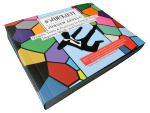By now all the different editions of my new book Management 3.0 #Workout are finished…

Visualizing My Objectives
I love the concept of OKRs (Objectives & Key Results) and while experimenting with this idea at Happy Melly, I’m trying to figure out how to adapt the practice to fit my own context. One thing my team members and I have noticed over the last few months is that it’s hard to remember what we have committed to.
As a virtual team, we don’t have a shared office where it’s easy to put stickies and pictures on the walls, reminding ourselves of what we need to focus on every day. Therefore, I have concluded, we should visualize our OKRs in the environments that we use most. For me, that means my Remember the Milk task lists. I have decided to reorganize all my lists in Remember the Milk today so that they correspond more directly to my OKRs. Each of my task lists is now either a direct contributor to an OKR, or else it is merely a list of ongoing work or some future ideas. I’ll give you three examples:
One of my current OKRs (for the 4th quarter of 2014) is as follows:
Objective: Successful book release of #Workout
Key Results:
- 2500 Kindle copies sold
- 1000 ePub copies sold
- 1500 paper copies sold
Until today, I had one giant task list for my Workout book, a small task list for my newsletter, and another one for my book tour. But now, after reviewing my OKRs, I decided to reorganize all book-related stuff into eight smaller lists that are much more manageable:
- MW-all
- MW-celebration
- MW-EPUB
- MW-KINDLE
- MW-newsletter
- MW-PAPER
- MW-pdf
- MW-tour
As you can see, all lists start with MW so that the work related to the Management 3.0 Workout book is sorted together in Remember the Milk. The lists MW-EPUB, MW-KINDLE and MW-PAPER are in uppercase as a visual reminder for myself of the key results that I intend to measure on January 1. The other lists are all in lowercase because I have no specific targets for them. Obviously, I have ongoing work concerning my book celebration, my book tour, my newsletter, and the free PDF version. But this work should take a backseat compared to the others. (The list MW-all contains a few tasks dealing with all book editions.)
Here is another OKR example:
Objective: Complete collaborative team at Happy Melly One
Key Results:
- 7 major roles addressed/covered
- 7 workout practices applied and documented
- 7 completed backlog items per week
- High team engagement (NPS > 50%)
Until today, I simply had one big Happy Melly task list. But not anymore! This is what I have now:
- HMO-BACKLOG
- HMO-ENGAGEMENT
- HMO-ideas
- HMO-PRACTICES
- HMO-ROLES
Again, these task lists start with HMO to keep them all together in Remember the Milk. Most tasks lists are capitalized to indicate that each of them is a direct contributor to one of my key results that I will measure on (or around) January 1. In this case, there is only one task list in lowercase (HMO-ideas) which contains some thoughts for future investigation that I don’t want to forget, but that I won’t focus on either.
One final example:
Objective: Active Management 3.0 inspiration machine
Key Results:
- Five fully-developed content modules
- Five fully-developed case studies
Until today, I had several task lists relating to Management 3.0 work. But interestingly enough, only of them was (indirectly) connected to my OKRs. I decided to change that as follows with this revised set of task lists:
- M30-CASE STUDIES
- M30-CONTENT MODULES
- M30-licensing
- M30-products
- M30-website
The task lists that I already had were about courseware licensing, physical products (games), the Management 3.0 website, and “new development”. Obviously, I have some ongoing work concerning license requests, selling products, and updating the website. But I changed my “new development” task list by splitting it in two, each one capitalized, and now directly feeding into my OKR. It made me realize I have been spending time on licensing, products and the website, but had almost completely ignored the case studies and content modules! My tasks lists did not reflect my commitment.
The benefit of all this rework?
My daily To Do list is a cross-section of all my task lists. I re-prioritize each task list once per week, and re-assess my work once per day. When I look at my daily task list (which I do many times per day) I can now immediately see which of my tasks contribute to my objectives, because the names of their lists are in uppercase. I also see which things I plan to do that are not part of what I should be focusing on. My To Do list is now a constant reminder of my OKRs, exactly what I have been missing for the last few months. I have successfully visualized my objectives, because I look at them every day.
Let’s see if this works.
image: (c) 2011 Mike Behnken, Creative Commons 2.0






